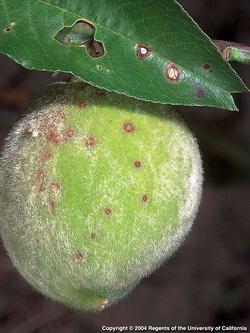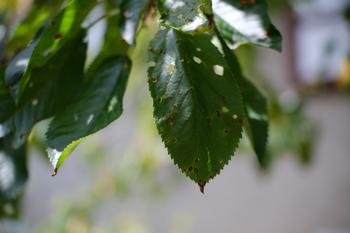Shot hole disease
-
Martha Proctor
-
Bad things can happen to good gardeners. Even though you make every effort to follow the general cultural guidelines for the trees and plants in your garden, problems can occur. To help keep track of what's happening in your garden, it is wise to monitor your plants and trees for any changes periodically. Before rushing out on a whim to buy a pesticide spray if damage is found, observe the symptoms on the affected plant, so the timing and choice of treatment are appropriate and effective to handle the problem.
 Shot hole disease on leaf and fruit. Photo: Guilhelm Vellut
Shot hole disease on leaf and fruit. Photo: Guilhelm VellutA case in point is shot hole disease. This is a disease in which .1/10" circular to irregular purplish or reddish water-soaked spots appear on the leaves, new buds, and shoots of prunus spp. family trees, especially apricot, cherry, peach, almond, or plum trees. Spots on young leaves usually have a narrow light green or yellow margin. Each leaf can have one or numerous holes and spots. Leaves with many holes will ultimately turn yellow and drop to the ground prematurely. Infected twigs show dark and sunken lesions. Fruit can also become infected, as evidenced by circular, brown, and slightly depressed spots.
At first glance, it might appear these holes were the work of an insect. But, in fact, shot hole disease is caused by the fungus Wilsonomyces carpophilus. The fungus causes tiny, dark brown bumps, spore-forming structures, to develop at the center of each lesion on affected parts. As noted, the fungus produces premature leaf drop, cankers on branches, spots on the upper surface of the fruit. Fruit spotting can be severe, and as fruits mature, spots change in appearance to become scabs and may flake off, leaving roughened areas beneath. Spores are produced throughout the winter on infected buds and twigs and are spread by rain & wind. The fungus can germinate and infect at temperatures as low as 36 degrees Fahrenheit.
Infection is favored by wet spring weather. Spores that land on twigs, buds, blossoms, or young leaves require 24 hours of continuous wetness to cause infection. Thus, the disease is most severe following warm, foggy or rainy winters and/or prolonged periods of wetness due to rain or sprinkler irrigation. Evidence of shot hole is most notable in spring as new growth is most susceptible. Shot hole fungus overwinters inside infected buds and twig lesions, where the spores can survive for several months. Thus, it is important to thoroughly inspect trees after leaf fall for any symptoms. Shot hole disease cherry on leaves
Shot hole disease cherry on leavesTo obtain guidance on what is infecting your plant/tree and address any issues that could promote infection, bring a fresh sample of all affected parts of the tree to the Marin Master Gardener Help Desk in Novato (www.https://marinmg.ucanr.edu/ASK_US/HELP_DESK/). The Master Gardener team or horticultural adviser can assess the damage and suggest measures to control or limit the spread of the disease.
Cultural practices are critical to minimizing the chance of infection and, if an infection is detected, the severity of the disease. Buds affected with the fungus are often covered with a shiny layer of exuded gum. Thus, the most important practice is to note, rake up, remove and destroy all fallen infected leaves, buds, blossoms, fruit, and twigs.
Avoid overhead irrigation to reduce transmission of the disease between branches or trees. Prune off lower branches to prevent foliage from getting wet from drip irrigation or low volume sprinklers. Destroy infected plant tissue and cankered twigs if present. Plant healthy new trees away from diseased trees/ plants and prune to provide good air circulation.
If the disease is severe on high-value plants, it is recommended that Bordeaux mixture, fixed copper, or certain synthetic fungicides such as chlorothalonil be applied after leaf drop but before the first fall rains. Bordeaux mixture—a combination of copper sulfate, lime, and water—is an effective fungicide that has been used for decades to control diseases of fruit and nut trees, vine fruits, and ornamental plants.


